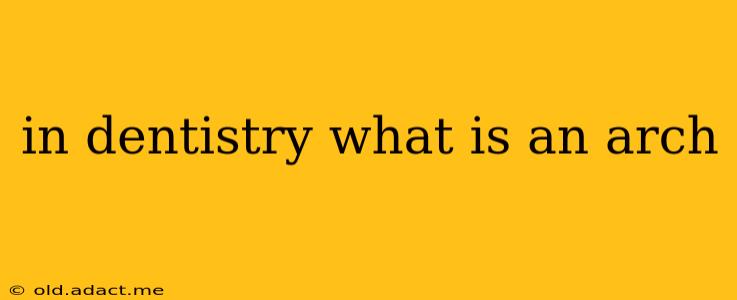In dentistry, an arch refers to the curved arrangement of teeth in either the upper or lower jaw. Think of it as the overall, horseshoe-shaped row of teeth. Understanding the dental arch is crucial for diagnosing and treating a wide range of dental conditions. This comprehensive guide will explore the intricacies of dental arches, clarifying common questions and providing valuable insights.
What are the Different Types of Dental Arches?
There are two primary dental arches:
- Maxillary Arch: This is the upper arch, located in the maxilla (the upper jaw bone). It generally has a wider and more U-shaped curve compared to the mandibular arch.
- Mandibular Arch: This is the lower arch, situated in the mandible (the lower jaw bone). It typically presents a more V-shaped or parabolic curve.
The shape and size of each arch are unique to an individual, influenced by genetics and various developmental factors. Variations in arch form can influence occlusion (the way the upper and lower teeth come together).
What is the Significance of Dental Arches in Orthodontics?
The dental arches play a pivotal role in orthodontics. Orthodontists meticulously analyze the alignment and relationship of the arches to diagnose malocclusions (bad bites). Treatment plans often aim to:
- Correct malocclusions: This includes addressing overbites, underbites, crossbites, and crowding.
- Improve aesthetics: Straightening the teeth within the arches improves the overall appearance of the smile.
- Enhance function: Proper arch alignment improves chewing, speech, and overall oral health.
Orthodontic appliances, such as braces and aligners, are carefully designed to move teeth into their ideal positions within the arches, optimizing both function and aesthetics.
How are Dental Arches Developed?
The development of dental arches is a complex process that begins in early childhood and continues into adolescence. Several factors influence their formation, including:
- Genetics: Inherited traits significantly impact arch size and shape.
- Growth and development: The growth of the jawbones directly influences the space available for teeth.
- Oral habits: Thumb sucking, tongue thrusting, and other habits can affect arch development.
What are the Common Problems Related to Dental Arches?
Several problems can affect dental arches, leading to various dental issues. Some of the most common include:
- Crowding: Insufficient space within the arch leads to overlapping teeth.
- Spacing: Excessive space between teeth, also known as gaps.
- Malocclusion: Improper alignment of the upper and lower teeth.
- Arch asymmetry: Uneven development of the right and left sides of the arch.
How are Dental Arches Measured?
Dental professionals use various methods to measure dental arches, including:
- Arch width measurements: Measuring the distance across the arch at specific points.
- Arch depth measurements: Assessing the anteroposterior (front-to-back) dimension of the arch.
- Models and photographs: Creating physical models or taking photographs of the arches for detailed analysis.
- Digital scanning: Using intraoral scanners to obtain precise three-dimensional images of the arches.
These measurements are essential for diagnosis, treatment planning, and evaluating the success of orthodontic treatment.
What is the Relationship Between Dental Arches and TMJ?
The temporomandibular joint (TMJ), which connects the jaw to the skull, is closely related to the dental arches. Malalignment of the arches can contribute to temporomandibular joint disorders (TMD), causing pain, clicking, and limited jaw movement. Therefore, proper arch alignment is crucial for overall oral health and function.
Understanding the complexities of dental arches is paramount for maintaining optimal oral health. This knowledge enables dentists and orthodontists to provide accurate diagnoses and effective treatments, ensuring a healthy and aesthetically pleasing smile for years to come.
